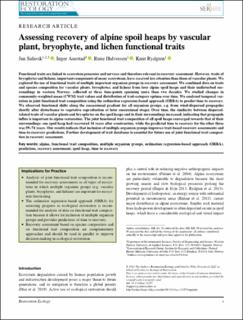| dc.contributor.author | Sulavik, Jan | |
| dc.contributor.author | Auestad, Inger | |
| dc.contributor.author | Halvorsen, Rune | |
| dc.contributor.author | Rydgren, Knut | |
| dc.coverage.spatial | Norway, Sogn og Fjordane | en_US |
| dc.date.accessioned | 2020-12-15T07:53:16Z | |
| dc.date.available | 2020-12-15T07:53:16Z | |
| dc.date.created | 2020-10-26T13:58:04Z | |
| dc.date.issued | 2020 | |
| dc.identifier.citation | Sulavik, J., Auestad, I., Halvorsen, R., & Rydgren, K. (2020). Assessing recovery of alpine spoil heaps by vascular plant, bryophyte, and lichen functional traits. Restoration Ecology. | en_US |
| dc.identifier.issn | 1061-2971 | |
| dc.identifier.uri | https://hdl.handle.net/11250/2719375 | |
| dc.description.abstract | Functional traits are linked to ecosystem processes and services and therefore relevant in recovery assessment. However, traits of bryophytes and lichens, important components of many ecosystems, have received less attention than those of vascular plants. We explored the use of functional traits of multiple important organism groups in recovery assessment. We combined data on traits and species composition for vascular plants, bryophytes, and lichens from four alpine spoil heaps and their undisturbed surroundings in western Norway, collected at three time‐points spanning more than two decades. We studied changes in community‐weighted mean (CWM) trait values and distribution of trait‐category optima over time. We analyzed temporal variation in joint functional trait composition using the ordination regression‐based approach (ORBA) to predict time to recovery. We observed functional shifts along the successional gradient for all organism groups, e.g. from wind‐dispersed propagules shortly after disturbance to vegetative reproduction at later successional stages. Over time, the similarity between dispersal‐related traits of vascular plants and bryophytes on the spoil heaps and in their surroundings increased, indicating that propagule influx is important in alpine restoration. The joint functional trait composition of all spoil heaps converged towards that of their surroundings: one spoil heap had recovered 34 years after construction, while the predicted time to recovery for the other three was 59–74 years. Our results indicate that inclusion of multiple organism groups improves trait‐based recovery assessments and time‐to‐recovery predictions. Further development of trait databases is essential for future use of joint functional trait composition in recovery assessment. | en_US |
| dc.language.iso | eng | en_US |
| dc.publisher | Wiley | en_US |
| dc.rights | Navngivelse 4.0 Internasjonal | * |
| dc.rights.uri | http://creativecommons.org/licenses/by/4.0/deed.no | * |
| dc.subject | alpine | en_US |
| dc.subject | functional trait composition | en_US |
| dc.subject | multiple organism groups | en_US |
| dc.subject | ordination regression-based approach (ORBA) | en_US |
| dc.subject | prediction | en_US |
| dc.subject | recovery assessment | en_US |
| dc.subject | spoil heap | en_US |
| dc.subject | time to recovery | en_US |
| dc.title | Assessing recovery of alpine spoil heaps by vascular plant, bryophyte, and lichen functional traits | en_US |
| dc.type | Peer reviewed | en_US |
| dc.type | Journal article | en_US |
| dc.description.version | publishedVersion | en_US |
| dc.rights.holder | © 2020 The Authors | en_US |
| dc.subject.nsi | VDP::Matematikk og Naturvitenskap: 400::Zoologiske og botaniske fag: 480::Økologi: 488 | en_US |
| dc.source.pagenumber | 1-12 | en_US |
| dc.source.journal | Restoration Ecology | en_US |
| dc.identifier.doi | 10.1111/rec.13257 | |
| dc.identifier.cristin | 1842323 | |
| cristin.ispublished | true | |
| cristin.fulltext | original | |
| cristin.qualitycode | 1 | |

